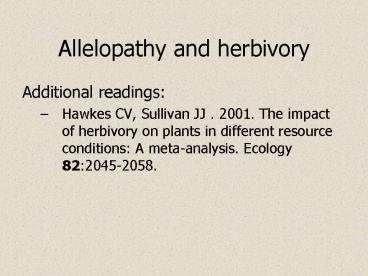Allelopathy and herbivory - PowerPoint PPT Presentation
1 / 25
Title:
Allelopathy and herbivory
Description:
Example: population consequences of herbivory on three Australian native plants. ... Three groups of grazing animals: domestic stock (sheep and cattle), native ... – PowerPoint PPT presentation
Number of Views:1099
Avg rating:3.0/5.0
Title: Allelopathy and herbivory
1
Allelopathy and herbivory
- Additional readings
- Hawkes CV, Sullivan JJ . 2001. The impact of
herbivory on plants in different resource
conditions A meta-analysis. Ecology
822045-2058.
2
Seminars
3
Outline
- Amensalism
- What is allelopathy and how is it inferred?
- plus-minus interactions
- Herbivory and importance in range and forest
- Trophic relationships top down VS bottom up
- Effects of herbivory
- Aspects of herbivory in range and forest
- Herbivore functional responses
- Sublethal effects and compensation (example)
4
Allelopathy
- Could be considered interference competition
for plants... - Definition
- Often mentioned, but hard to prove. Why?
5
Allelopathy
- Inferred by
- Spatial pattern/arrangement of plant community
- Presence of chemicals in leaves, roots and/or
soil - Demonstration that chemicals cause decline in
growth or survival of surrounding vegetation
6
Allelopathy
- Difficult to prove because
- Low chemicals in the field
- Mediated by 3rd party (e.g. microbes and litter)
- Trophic interactions similar to apparent
competition shrub harbours seed predator
causes allelopathic spatial arrangement.
7
Allelopathy
- Recent work on Centauria maculata (spotted
knapweed) provides good evidence for
allelochemicals. - Knapweed is an important rangeland weed what are
implications of allelopathy?
8
Amensalism
- Negative to one species, inconsequential to
other. - Often is actually very asymmetric
competition/pathogenesis - Example allelopathy
9
Plus-Minus relationships
- Include disease, parasitism, predation and
herbivory. - Effects on population (or biomass) can be
modelled using Lotka-Volterra equations to
predict population of prey and predators. - dV/dtVb-aPf1(V,P)
- dP/dtVkaV-df2(V,P)
- Where Vprey, Ppredators, bprey growth rate,
aprey consumption rate by predator, krate of
increase of predator per unit prey, and
dpredator death rate
10
Functional response
- Relationship of predator (herbivore) consumption
of prey (plants) to density of prey (plants) - 3 types unsaturating (I), saturating(II), and
sigmoidal (III) - Type of functional response has implications for
community structure and stability - Discuss further in lab
11
Herbivory
- What is the importance of herbivory?
- Small amount of biomass removed 10
- Tundra/alpine 3
- Forest 4
- Grassland 10-15
- Rangeland/grazing systems 30-60
- world is green hypothesis (who?) there is more
plant biomass than herbivores can eat. - Why? Trophic interactions.
- Top down control (predators)
- Bottom up control (plant forage quality)
12
Herbivory
- But trophic cascade models too simplistic
herbivory has more dramatic effects than they
predict... - Defensive compounds (coevolution)
- Community composition
- Productivity
- Seedling survival and demography
- Seed predation
13
Herbivory
- What are some of the effects of herbivores on
plants and plant communities?
14
Effects and issues
- Mortality of seedlings
- Insects VS vertebrates
- Herbivore outbreaks (insects especially)
- Sublethal effects and herbivory escape
- Compensatory growth and overcompensation
- Productivity
- Herbivore functional responses
- Resistance/defence
15
Forests
- Mortality of seedlings
- Insects
- Outbreaks (insects especially)
- Sublethal effects and herbivory escape
- Defensive compounds?
16
Rangelands
- Productivity
- Compensation/overcompensation
- Herbivore functional responses
- Toxicity and herbivore resistance
- Selectivity/preference
- Diversity and coexistence
17
Herbivore selectivity
- Plant stress VS plant vigour hypotheses
- Herbivores attack already stressed plants
- Herbivores favour plants in high resource areas
and with larger plant modules - Evidence for both
- Also influenced by herbivore defenses
- Can alter species composition and lead to
coexistence IF favoured species is best
competitor - Differs among herbivore species, therefore
management of different species can change
community composition
18
Compensation
- Response of plants to defoliation can vary
widely positive, negative or neutral - Compensation means plant growth increases after
herbivory to compensate for lost tissue - Overcompensation much discussed this means
plants are stimulated to grow MORE after
grazing/browsing. - Is overcompensation possible?
- Is compensation over extended periods possible?
19
Sublethal effects of herbivory
- Herbivores dont often cause mortality of adult
plants. - Can affect plants in other ways
- Reduced seed set/fruit abortion
- Reduced size/growth rate
- Change in architecture
- Delay or prevention of maturity
- These may all affect plant fitness (contribution
to next generation) - Example population consequences of herbivory on
three Australian native plants. Allcock and Hik
2004. Oecologia 138231-241.
20
Grazing experiment
- Three groups of grazing animals domestic stock
(sheep and cattle), native macropods (kangaroos
and wallabies), and introduced rabbits. - Four treatments control, stock fence, kangaroo
fence, rabbit fence. - Two habitats woodland (intact Eucalyptus canopy)
and grassland (cleared native pasture) - Three target species kangaroo grass (Themeda
australis), cypress pine (Callitris glaucophylla)
and white box (Eucalyptus albens)
21
Grazing experiment
- Plants placed in experimental plots in April 1998
- Monitored until April 2001.
- Generalized linear modelling used to analyze
factors affecting survival (habitat, grazing
animals, competition) - Survival and growth data used to parameterize
stage-based population models for trees.
22
Life history transition diagram
- Transitions between 5 size (height) classes for
trees final stage is escape from herbivory. - Models created for each habitat and treatment
combination.
23
(No Transcript)
24
(No Transcript)
25
Results
- Different herbivore species affected different
plant species (rabbits/kangaroos cypress stock
Eucalyptus) - Plants in productive environment better able to
compensate (more rapid growth) - High herbivory rate in unfenced low productivity
habitats prevented escape. - This could have population consequences even
though mortality was fairly low. - Interaction between competition and
herbivorytradeoff.

